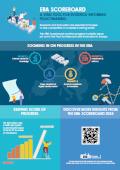The EU and the Member States have made substantial progress from 2010 to 2022 in key research and innovation areas across the EU, according to the European Research Area (ERA) Scoreboard and Dashboard 2024 published today. The reports provide insights and data on the progress made by EU Member States and countries associated to Horizon Europe on the four key ERA priorities: deepening a truly functional internal market for knowledge; taking up the green and digital transition and increasing society’s participation in ERA; enhancing access to research and innovation excellence across the EU; advancing concerted research and innovation investments and reforms.
The ERA Scoreboard and Dashboard are central features of the ERA Monitoring Mechanism, supporting evidence-informed policymaking within the ERA. The Scoreboard outlines progress in the four ERA priority areas at EU level through 19 research and innovation (R&I) indicators for which data is publicly available. The Dashboard offers a more granular analysis at national level based on more than 50 indicators, which showcase successes and areas for continued improvement.
2025 is a milestone year for the ERA, as we are celebrating 25 years of working together to achieve a single market for research and innovation, continuing to work on structural, economic and policy change in the ERA.
Key insights: Positive developments and areas for improvement
The 2024 edition of the ERA Scoreboard shows that the EU has advanced in several areas between 2010 and 2022, namely in open science, gender equality and global engagement. For example, during the above period, the share of publications available in open access in the EU grew from 56.8% to 77.7%, and the proportion of women in the highest grade (Grade A) among academic staff increased from 19.7% to 27.3%. Substantial positive change was also observed in the percentage of foreign doctorate students in the EU, which raised from 16.3% to 22.7%. In general, the share of Gross Domestic Expenditure (GDP) dedicated to Research & Development increased from 1.97% in 2010 to 2.27% in 2022.
Despite the upward trends, the report identifies areas that would benefit from further improvement, varying from collaboration between companies and research institutions to the prioritisation of long-term research and innovation (R&I) investments and policy reforms. The Scoreboard findings underscore the need for continued investment in human and financial R&I resources and partnerships to further Europe’s competitiveness and sustainability.
The ERA Dashboard offers a detailed assessment of progress towards the ERA priorities at national level, including EU Member States and countries associated to Horizon Europe. The report shows that countries advanced considerably in open science, research infrastructures and global engagement. However, challenges remain in improving research mobility and enhancing collaboration between academia and industry. On addressing the green and digital transition, some countries have shown sustained commitment to environmental R&D investment, but others continue to face decline or low performance in key areas, highlighting the need for more focused policy interventions.
Widening Countries, which are EU Member States and Associated Countries that are less advanced in R&I, are improving their R&I ecosystems. However, asymmetries remain, particularly in the efficient use of public funds and in collaboration capacity with external partners. Finally, results point to the need for an increase in private-sector R&I funding in most countries.
Next steps
Both reports will be complemented by the upcoming 18-months EU-level Monitoring Report, as well as dedicated ERA Country Reports, which assess the state of play of the implementation of the ERA Policy Agenda at EU and national levels. The adoption of the second ERA Policy Agenda 2025-27 is expected soon, under the Polish Presidency of the Council of the EU.
Infographics
ERA Scoreboard 2024: A vital tool for evidence-informed policymaking
Research and innovation are essential for Europe to stay competitive in a rapidly evolving world. The ERA Scoreboard monitors progress in priority areas set out in the Pact for Research and Innovation in Europe.
ERA Scoreboard 2024: A snapshot of progress in the European Research Area
In the European Research Area, countries have made research & innovation a priority in 4 areas set out in the Pact for Research and Innovation in Europe. What is the state of progress at EU level?
ERA Scoreboard 2024: Key Takeaways
Since 2010, there has been major progress in several priority areas across the European Research Area.
Background
The European Research Area (ERA) aims to create a unified research and innovation market by aligning national and EU policies, improving research infrastructures and promoting open science and international collaboration. The ERA was officially launched in 2000, following its proposal by the European Commission in a communication titled ‘Towards a European Research Area’, further endorsed by the European Council and is enshrined as an objective in Article 179 of the Lisbon Treaty.
The current ERA policy framework is the result of a revitalisation process started in 2021, which has led to a new ERA governance, the Pact for R&I and the first ERA Policy Agenda 2022-24.
More information
ERA Scoreboard 2024
ERA Dashboard 2024
European Research Area Policy Platform
Video: European Research Area (ERA) Scoreboard and Dashboard 2024
Press contact:
EC Spokesperson for Research, Science and Innovation

